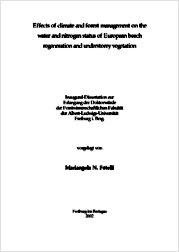Effects of climate and forest management on the water and nitrogen status of European beech regeneration and understorey vegetation
Fotelli, Mariangela N
Univ. Freiburg (Breisgau)
Monografie
Verlagsversion
Englisch
Fotelli, Mariangela N, 2002: Effects of climate and forest management on the water and nitrogen status of European beech regeneration and understorey vegetation. Univ. Freiburg (Breisgau), 41 S., DOI: 10.23689/fidgeo-382.
 |
Dokument öffnen: |
Human activities result in climate changes with various impacts on forest ecosystems. An increase in global surface temperature, compared to pre-industrial levels, is already recorded and further elevation is expected. Extreme events, such as hot and dry periods, would increase in frequency and duration in near future. Due to the low adaptive capacity of forest ecosystems to rapid climate changes, high priority is given to the assessment of their responses. Particularly, studies on forests dominated by the drought susceptible European beech, especially when grown on limestone-derived soils with low water storage capacity, being common in Central and Southern Europe, are important. Moreover, climate models emphasize the significance of management practices for the adaptation to the expected changes, since they could contribute to the mitigation of possible adverse effects of climate change. The present study assessed the effects of different climatic conditions on the nitrogen and water status of natural beech regeneration grown in managed (thinned) and not managed (control) stands in a forest in Southern Germany. A SW-exposed site, characterized by low water availability and high temperature and radiation interception, was regarded as representative of the climate conditions expected in the future, whereas a NE-exposed site was used as typical of present climatic conditions...

